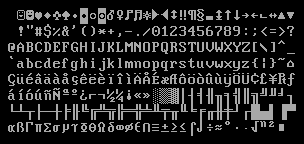Discussion forum for all Windows batch related topics.
Moderator: DosItHelp
-
einstein1969
- Expert
- Posts: 961
- Joined: 15 Jun 2012 13:16
- Location: Italy, Rome
#1
Post
by einstein1969 » 19 Aug 2015 20:40
I probed to display the chars in this
articles
using dbenham
char macrosWith the Lucida console all work but if I choose Terminal Font don't work!
I want use the Terminal font because the "shadow char" are better.
Why the terminal font in codepage 437 don't show the same characters above (shadow chars+others)?
It's possible a workaround? Can anyone test and post results?
Code: Select all
@echo off
setlocal disableDelayedExpansion
For %%C in (437 850 1252) do (
chcp %%C
call charMacros
call :print
echo(
)
pause>nul
exit /B
:print
setlocal enableDelayedExpansion
set "S="
for /l %%N in (0 1 255) do (
set /A "r=%%N %% 32"
if !r! equ 0 echo(!S!&set "S="
%@chr% %%N c
for %%E in (0 7 8 9 10 13) do if %%N equ %%E set "S=!S! "&&(call)
if NOT !Errorlevel! equ 1 set S=!S!!c!
)
echo(!S!
endlocal
exit /B
I think that American PC (like Dbenham's PC) can view the codepage 437 in terminal font without problem. It's right?
my result:

Einstein1969
-
Liviu
- Expert
- Posts: 470
- Joined: 13 Jan 2012 21:24
#2
Post
by Liviu » 20 Aug 2015 10:35
Terminal is a raster font, and is codepage specific. In your case the OEM codepage of the Windows installation is 850, and Terminal matches Lucida Console under chcp 850. That's the expected behavior, see for example
http://www.microsoft.com/resources/documentation/windows/xp/all/proddocs/en-us/chcp.mspx?mfr=true: "
Only the original equipment manufacturer (OEM) code page installed with Windows XP appears correctly in a command prompt window that uses Raster fonts".
You might try to change the default OEM codepage to 437 via "change language for non-unicode programs" to English-US somewhere in Control Panel under Regional settings depending on Windows version. But that's a system wide setting and could have unexpected side effects.
Liviu
-
einstein1969
- Expert
- Posts: 961
- Joined: 15 Jun 2012 13:16
- Location: Italy, Rome
#4
Post
by einstein1969 » 25 Aug 2015 15:11
@Liviu
Thanks for this information.
So the choice of the raster font is the worst choice to make if you want to write an application that is executed in the same way on different PCs around the world?
and so in the case of raster fonts choosing the codepage it is irrelevant?
In addition to changing the locale settings there is no way to programmatically check if we are on a machine that can not display a given character / glyph?
@penpen
Thanks for point me in this direction. I will use the Carlos's fonts but after there is no other possibility
or as an option.
einstein1969
-
Liviu
- Expert
- Posts: 470
- Joined: 13 Jan 2012 21:24
#5
Post
by Liviu » 25 Aug 2015 20:54
einstein1969 wrote:So the choice of the raster font is the worst choice to make if you want to write an application that is executed in the same way on different PCs around the world?
Pretty much, yes.
einstein1969 wrote:and so in the case of raster fonts choosing the codepage it is irrelevant?
As far as output goes, yes. The active codepage still affects input translation (try for example entering the ALT+224 and ALT+0224 characters in codepages 437, 850, 1252).
einstein1969 wrote:In addition to changing the locale settings there is no way to programmatically check if we are on a machine that can not display a given character / glyph?
Not from batch language.
Liviu

